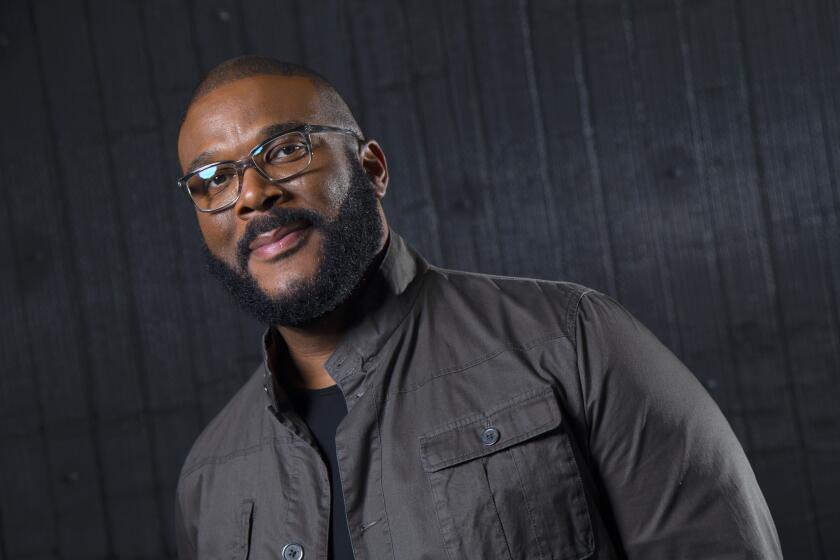Review: ‘The 15:17 to Paris’ turns a headline grabbing true story into a lackluster Hollywood movie
- Share via
In 1921, Louis Sonney, having single-handedly captured bandit Roy Gardner, “the most hunted man in Pacific Coast history,” played himself in a film called “Crime Doesn’t Pay” and toured the nation with it on the Pantages vaudeville circuit.
In 1955, Congressional Medal of Honor winner Audie Murphy, America’s most decorated World War II soldier, played himself in a Technicolor and Cinemascope version of his wartime exploits, “To Hell and Back,” which became a major hit.
Now, in 2018, Anthony Sadler, Alek Skarlatos and Spencer Stone play themselves in director Clint Eastwood’s “The 15:17 to Paris,” the once-again true story of how a trio of friends disarmed a heavily armed terrorist intent on killing as many as possible of the 500-plus passengers on a train speeding to Paris from Brussels.
As a democratic culture, Americans are understandably attracted to the notion of everyday heroes, of brave warriors hidden in plain sight, people ordinary on the surface but possessed of astonishing reserves of courage that reveal themselves when emergency calls.
Eastwood dealt with a similar situation in 2016’s “Sully,” starring Tom Hanks as the intrepid real-life commercial airline pilot who made a successful emergency landing on the Hudson River in the dead of winter, so he understands that these stories demand the just-the-facts style of direction he’s so good at providing.
But though the sequences of the actual heroism on the Paris-bound train are fully as crisp and involving as you’d expect, the other sections of the film, intent on demonstrating how undeniably everyday the three participants were up to that crucial moment, fall regrettably flat.
All indications to the contrary, despite the attempts of first-time screenwriter Dorothy Blyskal (working from a book Sadler, Skarlatos and Stone wrote with Jeffrey E. Stern), there does not appear to be an involving feature film in their story, undeniably heroic though it is.
The nearly 50 movies Murphy went on to make after “To Hell and Back,” notwithstanding, Eastwood took a risk in casting the real protagonists in their own story.
Though none of the trio should give up their day jobs just yet, it’s not their lack of compelling charisma that is the picture’s main problem, but rather that the on-screen story has not come up with anything compelling for them to do outside those few life-and-death minutes on the train.
The film teases that attack from its opening frames of an ominous looking man walking through the Brussels train station on the way to boarding the 15:17, but soon flashes back to one of its major focuses, a bland after-school special-style examination of the bond the men forged as middle-school students in Sacramento circa 2005.
No one, to put it mildly, sees these kids as potential heroes. Rambunctious but good-hearted, young Spencer (William Jennings) and Alek (Bryce Gheisar) get sent to the principal’s office a lot, much to despair of their struggling single parent mothers, played by Judy Greer and Jenna Fischer, who nevertheless have their backs.
At that office is where the boys meet young Anthony (Paul-Mikél Williams), also a frequent subject of Christian school discipline. The three become fast friends, sharing an interest in war and weaponry and listening intently when a teacher, in one of the movie’s numerous bits of foreshadowing, talks of Franklin D. Roosevelt as someone who “did the right thing at the right time to defuse critical situations.”
This marking-time itinerary tests the limit of how much the buying of gelato and the taking of multiple selfies can involve us.
As adults, the three go their separate ways and lead what appear to be haphazard lives. Sadler enrolls at Cal State Sacramento and is not heard from a lot, while Skarlatos is deployed by the Oregon National Guard to what looks like a nondescript tour in Afghanistan.
Stone, seen reciting the Prayer of St. Francis, has a strong sense of mission. That takes him to the Air Force, but he has a lot of false starts there, which we see in uninvolving detail. Still, he continues to stubbornly believe “life is just pushing us toward something, some greater purpose.”
The friends decide to reunite on a European vacation, but before we get to the train trip that made them famous, we are shown a detailed rundown of all the standard sights they took in — including the Trevi Fountain and the Colosseum in Rome, the bars of Amsterdam, the canals of Venice, the city’s iconic Piazza San Marco and pricey Gritti Palace restaurant, to name just a few.
While it is nice to have the regular-guydom of these men highlighted, this marking-time itinerary tests the limit of how much the buying of gelato and the taking of multiple selfies can involve us.
As noted, the disarming of the terrifying El Khazzani is well presented in a “You Are There” way and gives us a real sense of the kind of bravery involved. A single act of heroism can truly transform a life, but that action does not necessarily make for a transformative motion picture.
‘The 15:17 to Paris’
Rating: PG-13 for bloody images, violence, some suggestive material, drug references and language
Running time: 1 hour, 33 minutes
Playing: In general release
See the most-read stories in Entertainment this hour »
Movie Trailers
More to Read
Only good movies
Get the Indie Focus newsletter, Mark Olsen's weekly guide to the world of cinema.
You may occasionally receive promotional content from the Los Angeles Times.








